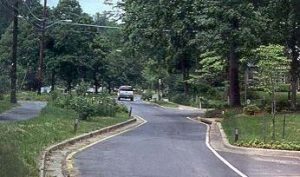Horizontal Displacement: Chicanes or Serpentines
Chicanes or serpentines are short, horizontal displacements in the roadway that create a curvilinear alignment, which encourages slower speeds.

Chicanes are short, horizontal displacements in the roadway that create a curvilinear alignment, which encourages slower speeds (Andrle et al. 2001).
Chicanes are also called serpentines, as the physical constrictions at curbside create a 45 degree bend in a straight road, which forces drivers to negotiate the narrowed street in a snakelike fashion (Ewing 1999). Traditional chicanes often require a change in the roadway alignment given they physically change the roadway.
Advantages
- Negotiating curves forces drivers to slow down
- Chicanes can be aesthetically pleasing
Disadvantages
- Potentially leads to high costs for curb realignment and landscaping
- Drainage problems (ponding) can occur
- Potential for head-on collisions
- May be difficult for large trucks and farm equipment to negotiate if not designed properly
- Can have a negative impact on emergency response times
Effectiveness
Chicanes were evaluated on an arterial in Toronto, Canada. The roadway was 28-feet-wide and chicanes were created using modular traffic-calming islands. The road was narrowed to 21 feet with chicanes. A reduction in the 85th percentile speed from 50 km/h to 45 km/h occurred (Macbeth 1998).
No crash modification factors (CMFs) were found relating to chicanes.
Appropriateness
Chicanes, when properly designed, may be appropriate for rural main streets. Special considerations must be given to geometrics if there is a high percentage truck traffic, because curb overtopping could be a problem. Consideration must be given to alignment so that heavy trucks and farm equipment are able to negotiate the roadway safely.
Cost
Cost is highly dependent on the roadway setting. Temporary or seasonal chicanes are other options.
References
Andrle, Stephen J., Keith K. Knapp, Tom McDonald, and Duane E. Smith. Iowa Traffic Control Devices and Pavement Markings: A Manual for Cities and Counties. Center for Transportation Research and Education, Ames, IA, 2001.
City of Winston-Salem, North Carolina. “Traffic Calming Policy. Section IV.” Traffic Calming Measures, 2003.
Ewing, Reid. Traffic Calming: State of the Practice. Washington, DC: Institute of Transportation Engineers, U.S. Department of Transportation, 1999.
Macbeth, Andrew G. Calming Arterials in Toronto. Presented at annual meeting of the Institute of Transportation Engineers, 1998.
